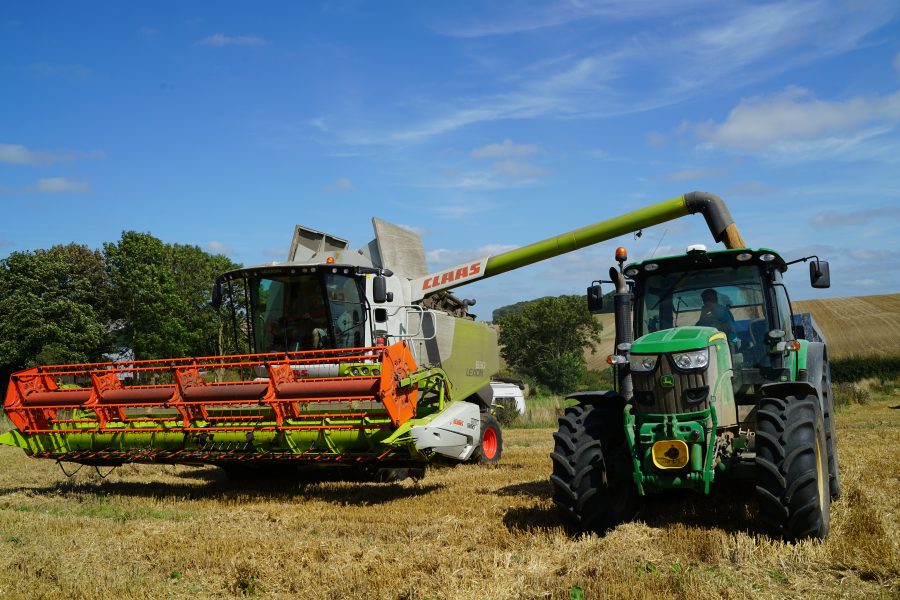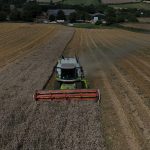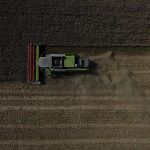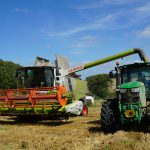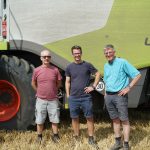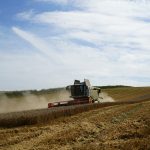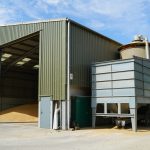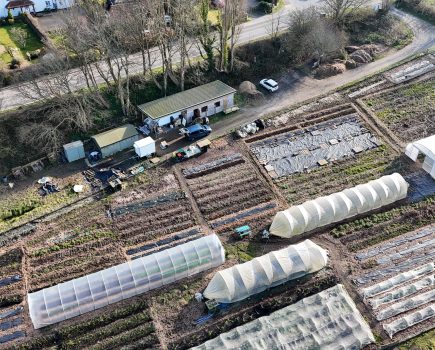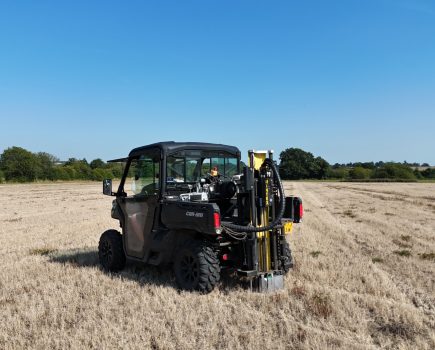This month Nigel Akehurst visits Housedean Farm in Lewes to meet father and son team David and Nick Taylor to find out more about their mixed family farming and diversification businesses.
Housedean farm is in the South Downs National Park just off the busy A27 dual carriageway between Lewes and Brighton. Arriving off the slip road, I parked outside the camp site reception and café, where I was greeted by father and son team David and Nick Taylor.
Nick had been busy carting wheat back to the yard, he said, and they were hoping to finish off the last couple of fields to complete harvest before the rain arrived.
David headed off in the John Deere tractor, leaving Nick and I to chat. “Compared to last year, harvest has been relatively straightforward, but yields are down,” he said.
The best winter wheats have been coming off at around nine tonnes to the hectare, he explained, but they would normally expect closer to 10.
The wet winter hasn’t helped, but they’ve also had issues with a new disc drill and a fertiliser spreader that left stripes in the fields. “We are having trouble getting to the bottom of the issues,” he said.
Their spring barley has been coming off at about six to six-and-a-half tonnes a hectare, where they would normally expect seven-and-a-half to eight.
After a couple of profitable years for arable farmers, this year has been a big reality check, he said. With Basic Payments rapidly decreasing, Nick said he was glad they no longer relied on just the farm for their income.
Growing up on the farm with four other siblings (one of whom – Ben Taylor, the managing director of Iford Estate – I interviewed last February) Nick never dreamed of taking over the farm.
“I went to university because that’s what everyone did. I was quite happy in my job but started to think: ‘Can I imagine doing this for the next 30 years?’” he said.
He was an environmental consultant and found himself spending more and more time in the office as he became more senior. Getting a bit fed up, he started a small farm camp site as a side hustle at the weekends.
Starting a campsite venture
Started in 2010 with a few camping pitches and a portable toilet, the venture quickly took off. It wasn’t long before Nick decided to leave his job to focus on the camp site full time.
Fast forward 14 years and the camp site now has 28 camping pitches (with each pitch capable of taking up to eight people), three pods, a shepherd’s hut and a pig ark, complete with outdoor bath.
The site charges £16 per adult and £7 per child for the pitches and all bookings are taken upfront via their website:
www.housedean.co.uk.
When full, the camp site can accommodate up to 120 people, which is the maximum capacity the block of loos and hot showers can handle, he said. Weekends are nearly always fully booked and the site is also busy through the week during the school summer holidays.
I asked Nick whether he had any trouble gaining planning permission. “Planning was okay,” he replied, explaining that it went through before the area became a national park, so the council was a little less hot on things like tents and cars.
The camp site opens at the end of March or the beginning of April and closes from October onwards, when it’s nice to get the place back for the off-season, he added.
“It’s been a good farm diversification,” he said, with the venture having grown big enough to employ a manager and a small team of helpers.
Nick said that before they employed someone it had been getting too time consuming, taking him away from doing what he needed to be doing, which was being more involved in the management of the arable enterprise.
Getting more involved in the farm and taking over the tenancy
Over the years, Nick has become more involved in the running of the farm, and he moved into the farmhouse three years ago with his wife Lydia and their three young daughters (his parents David and Bridget now live down the road, he explained).
As well as working on the farm alongside his dad, Nick has managed to set up other farm diversification ventures, something he finds rewarding.
“It’s not so much running the diversifications I find rewarding, but setting up the business and knowing you’ve got a guaranteed income that doesn’t rely on the weather,” he clarified.
In 2019 they converted an old cattle hovel into a one-bedroom holiday let with the help of LEADER funding under the tourism and leisure diversification fund, which they finished just as Covid-19 hit.
They named it The Hovel and it is let via Sawdays and has been a great success, bringing in around £170 a night during peak times.
Looking around the space, it was clear that the renovation, made viable by the LEADER funding, has been done to a high spec.
“It’s always difficult because we’re tenants; it’s hard to justify spending money on someone else’s building so you’ve got to be sure you’re going to get a return on it over a reasonable timescale,” he explained.
Nick is now the tenant at Housedean Farm, carrying on the Agricultural Holdings Act tenancy for his lifetime. They also have other bits of land on farm business tenancies.
“We have been prepared to invest in buildings and treat the farm as our own. If you don’t, everything can easily become run down and tired,” he added.
The latest diversification is a fitness studio housed in a sleek, new, black barn. Inside the spacious ply-lined building with Crittal windows, is an impressive collection of weight-lifting equipment belonging to the personal trainer tenant.
The total cost of the build was supported by a 40% Farming in Protected Landscapes grant. Nick doesn’t expect it will take long to see a return on their investment.
I asked him if they had reached a tipping point where the farm diversifications brought in more money than the farm. He replied that had often been the case, apart from the past couple of years when the arable prices had been a bit better. But he said the farm was necessary to facilitate the diversification and added that it was good to have the variety of income streams.
“Some years in the past the farm has just broken even, and Basic Payment has been the profit. With the BPS decreasing, the farm diversifications can bring in useful income with less risk and less work,” he said.
Future of arable farming
The father and son team is currently considering whether to continue arable farming on the same scale or focus more on environmental schemes, with their current Countryside Stewardship agreement coming to an end in January.
For interest, Nick asked their farm advisors CLM to do a desk-based exercise to look at how much they could make if they put the whole farm down to Sustainable Farming Incentive schemes.
“It was a significant sum, but you would have to get rid of most of your equipment and perhaps just keep a tractor, a drill and a topper- enough kit to drill cover crops,” he said.
His hesitation is over the possibility of the Government changing the SFI rates in three years. “You’re either in or you’re out, once you’ve sold all your kit it’s very hard to go back,” he said.
“We can’t cut down our arable area any further without our fixed costs being too high.”
On the topic of food security, Nick said: “I do think food security is important for the country but I don’t feel a personal responsibility on our farm to produce food, particularly because the land we farm is relatively unfertile.
“We’re contributing, but as I say to dad, we’re producing malting barley for beer and we’re producing wheat for animal feed – so we’re not directly producing food for humans.
“Ultimately, we’ve just got to run a business that’s profitable, that makes money. We can’t just keep farming out of habit; we have got to look at it like any business person would and if we’re not making money then we need to ask how we can change to make sure we remain profitable.”
I asked if scale was the answer. Scale probably would help but then there’s more risk; your fertiliser bill is twice as big, you need more labour and there’s more rent to pay. It’s not a step we are thinking of taking. If anything we’ve downsized a bit, losing 80 hectares a few years ago, he replied.
Challenges of regen ag and farm labour
Since getting more involved in the arable farming side of the business, David and Nick have started planting more cover crops and moved to min tilling rather than ploughing.
They’ve also taken up more environmental options, but Nick said the interface between farming and countryside stewardship wasn’t easy. He has seen a big increase in weeds, and black grass has become a big issue since they stopped ploughing, he added.
This autumn they plan to reintroduce the plough again to bury the weeds but will continue to reduce tillage where possible to build soil organic matter.
They are also using a variable rate nitrogen spreader to apply nitrogen where it is needed, but admitted they’ve had a few issues with machinery, resulting in large stripes in the fields.
John Barrow, their main tractor driver, has worked for the family for 45 years, and when he decides to retire it will be difficult to replace his skills and the knowledge of the farm that he has built up over those years.
Suckler herd
The other main farming enterprise on the farm is a herd of 40 suckler cows that grazes the 170 hectares of grass, mainly bits of ground that aren’t suitable to be cultivated.
“We don’t have enough animals to eat all the grass, but we do have a bit of sheep keep,” Nick added.
Dad is very much the “cow man”, he said, adding that they’d had a tricky couple of years with difficult calvings and some deformed calves due to toxicity from their silage.
They are now in the process of changing from Holstein cross cows to Shorthorn in the hope of easier calvings and fewer problems. They have got rid of their old Simmental bull and replaced him with a Shorthorn.
Currently they calve in July and wean in May, selling stores in Hailsham Market at around 12 to 14 months. The best steers can fetch around £1,200, he said.
All the cattle come into the barn during the winter months, but Nick would like to try out-wintering to free up valuable barn space.
Seeing the combine working and plans for the future
With my visit coming to an end, we jumped in Nick’s pickup and headed out to see their Claas combine working in the field..
As someone who grew up on a small farm in the High Weald, I am always blown away by the scale of the fields on the South Downs and managed to get a few good drone shots of the combine with the Amex stadium in the background (Nick is a Brighton FC season ticket holder). I also captured a team shot of Nick, David and John standing in front of the combine.
Driving back to the farmyard, I asked Nick if he had any other plans for farm diversification. He replied that they might expand the small cafe in the camp site reception, which has worked well, attracting cyclists on the South Downs Way that runs through the farm. He also said they were planning to upgrade a few of the ageing glamping pods to more bespoke units.
- David and Nick Taylor with John Barrow (combine driver)
Farm facts
- Located in the South Downs National Park
- 270 hectares of arable, split between winter wheat, oilseed rape and spring barley
- 170 hectares of grass
- All chalk downland with some areas of clay capping
- 40 suckler cows and recently bought a Shorthorn bull to replace their old Simmental
- Stores sold at Hailsham market at between 12 and 14 months
- A tiny camp site started on the farm in 2010 has grown to 28 pitches and five glamping units, with a full-time camp site manager during the season
- All bookings taken via their website www.housedean.co.uk
- Converted an old cattle hovel into a high-spec, one-bedroom holiday let with the help of LEADER funding in 2019
- New on-site fitness studio built with help of Farming in Protected Landscapes funding
- Moving from Countryside Stewardship to Sustainable Farming Incentive next year
- Storage containers housed undercover in barns
For more like this, sign up for the FREE South East Farmer e-newsletter here and receive all the latest farming news, reviews and insight straight to your inbox.

